
Picture a dimly lit theater, the air thick with anticipation as the opening credits roll. Suddenly, the screen bursts to life with a flawless, vibrant image that transports the audience to a bygone era. This is the magic of classic film restoration – breathing new life into cinematic treasures that have captivated generations.
In a time when technology advances at a rapid pace, the importance of preserving and revitalizing classic films has never been more crucial. As audiences crave immersive, high-quality viewing experiences, the demand for remastered movies has soared, offering a chance to rediscover the timeless stories and iconic performances that have shaped the art of filmmaking.
From the moody black-and-white masterpieces of the Golden Age to the bold, technicolor epics of the 1960s, the process of restoring these cinematic gems involves meticulous attention to detail and a deep reverence for the original creators’ vision. Through digital remastering, painstaking frame-by-frame cleaning, and the careful recovery of lost audio and visual elements, these classic films are elevated to new heights, captivating audiences with their renewed splendor.
Key Takeaways
- Classic film restoration breathes new life into timeless cinematic treasures.
- The demand for remastered movies has soared as audiences crave immersive, high-quality viewing experiences.
- The restoration process involves meticulous attention to detail and a deep reverence for the original creators’ vision.
- Digital remastering, frame-by-frame cleaning, and the recovery of lost audio and visual elements elevate classic films to new heights.
- Restored classics offer audiences a chance to rediscover the iconic performances and timeless stories that have shaped the art of filmmaking.
Introduction to Film Restoration
Preserving the cinematic heritage of classic films is a crucial task, ensuring that timeless stories and the evolution of the art form are accessible to new generations. Film restoration is the process of reviving and revitalizing these timeless treasures, breathing new life into the captivating worlds of old movies.
The Importance of Preserving Classic Movies
Classic films provide a unique window into the past, offering audiences a genuine taste of life and filmmaking in another era. These movies are more than just entertainment – they are cultural artifacts that reflect the values, aesthetics, and technological advancements of their time. Restoring and preserving these films is essential to keep these stories alive and accessible for the future.
The Magic of Old Movies
Old movies possess a special magic that captivates viewers, showcasing the evolution of the art form and the cultural values of the time period. From the iconic black-and-white films of the silent era to the vibrant Technicolor masterpieces of the Golden Age, these classic films transport us to a different time, evoking a sense of nostalgia and wonder. Restoring these cinematic gems allows audiences to experience the full impact of these timeless stories and cinematic heritage.

“Preserving our film restoration heritage is not just about nostalgia, but about honoring the creative vision and technical innovation that shaped the art of filmmaking.” – Martin Scorsese, Academy Award-winning Director
The Film Restoration Process
Reviving classic films is a meticulous endeavor that involves the skilled restoration of original materials. The film restoration process begins with sourcing the best available elements, such as camera negatives and sound recordings, to digitize them at high resolutions. This crucial step lays the foundation for the subsequent picture and audio restoration techniques.
Sourcing and Digitizing Original Materials
The restoration team meticulously searches for the most pristine source materials, often working with film archives and private collectors to uncover the best available elements. These materials are then carefully digitized, preserving the original visual and auditory qualities at the highest possible quality. This digitization process is a vital step in preparing the film for restoration.
Picture and Audio Restoration Techniques
With the digitized materials in hand, the restoration experts embark on the painstaking task of addressing various issues that may have accumulated over time. This includes removing dirt, scratches, and instability from the picture, as well as reducing noise and enhancing the audio quality. Advanced technologies, such as frame-by-frame analysis and color correction, breathe new life into the film, restoring its original vibrancy and clarity.
The restoration process also involves close collaboration with the original filmmakers and production staff, ensuring that the final version aligns with the director’s original vision and preserves the film’s historical significance. This meticulous attention to detail is essential in honoring the artistic integrity of classic cinema.
| Restoration Technique | Purpose |
|---|---|
| Frame-by-frame analysis | Maintains visual integrity by meticulously addressing issues on a frame-by-frame basis |
| Color correction | Restores vibrancy and balance to faded frames, adjusting hues, contrast, and saturation |
| Sound enhancement | Reduces background noise, sharpens dialogue, and expands the dynamic range for an immersive auditory experience |
| Up-scaling techniques | Breathes new life and clarity into films by enhancing resolution and revealing previously lost details |
The film restoration process serves as a bridge, connecting the origins of filmmaking with the modern industry. By preserving the cultural heritage of classic cinema, restoration efforts ensure that the stories, artistic expression, and historical significance of these cinematic gems are upheld for future generations to discover and appreciate.
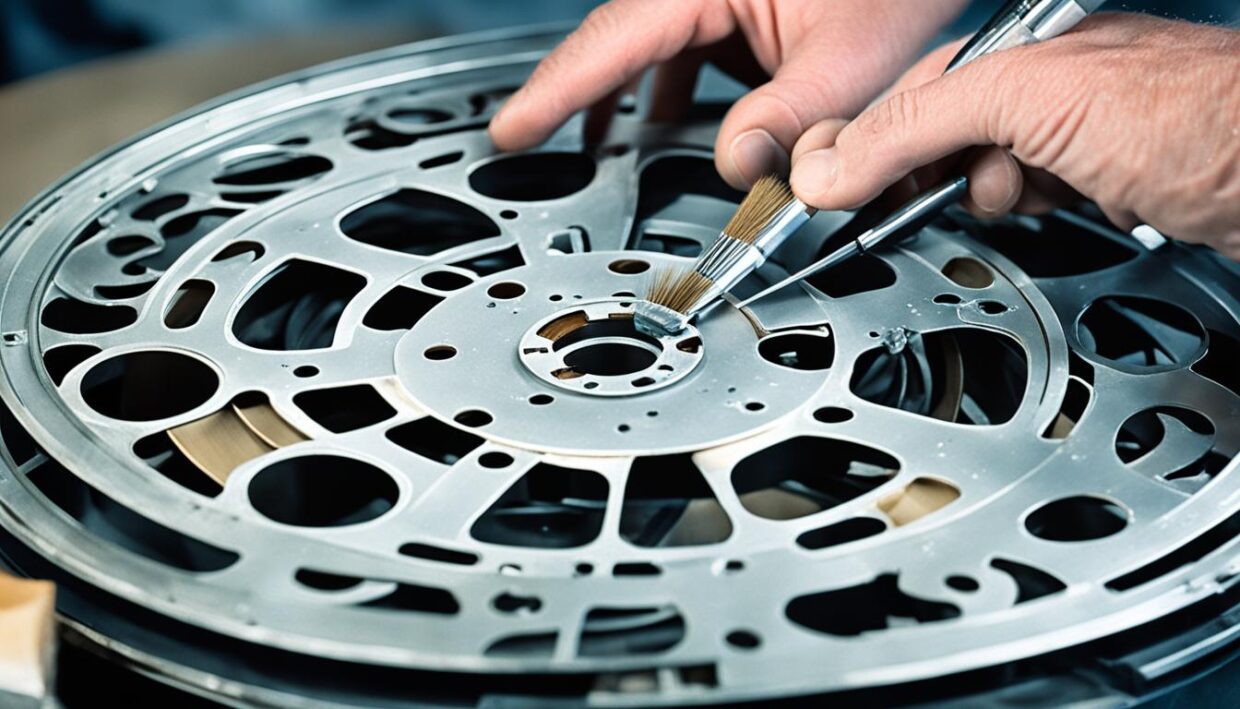
Challenges in Film Restoration
Restoring classic films can be a daunting task, as the restoration team often faces a range of challenges depending on the condition and availability of the original materials. In some cases, the camera negatives or sound elements may be incomplete, damaged, or even lost, forcing the restoration team to work with less-than-ideal source materials and find creative solutions to overcome these obstacles.
One major challenge is dealing with damaged materials. Many classic films were stored improperly over the years, leading to deterioration, discoloration, and physical damage. Olympusat Entertainment, a company that has been restoring classic motion pictures for over 7 years, has encountered films stored in attics, old storage trunks, and even garbage bags, all of which have taken a toll on the film’s condition.
Incomplete elements can also pose a significant challenge. If crucial footage or audio is missing, the restoration team must work to fill in the gaps using alternative sources or through digital techniques. This process requires a keen eye for detail and a deep understanding of the original film’s style and intent.
- Identifying and evaluating the best elements for use
- Scanning for quality and execution
- Repairing film damage from aging or production
- Grading restoration titles to maintain original intent
- Taking advantage of new advancements in HDR and color formats
Film restoration can be an extremely demanding and technical process, pushing colorists to their limits as they work to bring damaged films back to life. Olympusat Entertainment, which owns, operates, or manages over 50 OTT television channels, has encountered such challenges, with some colorists even leaving the restoration team due to the difficulties involved.
Overcoming these challenges requires a combination of expertise, creativity, and a deep respect for the original film. By leveraging the latest technologies and techniques, restoration teams can breathe new life into classic cinema gems, preserving these treasures for generations to come.

Choosing Films for Restoration
The decision to restore a classic film is not taken lightly. It is based on the availability and condition of the original materials, as well as the restoration team’s belief that they can produce a superior master version compared to what has been previously available. When possible, the restoration team collaborates closely with the original filmmakers, such as directors and cinematographers, to ensure the restored version stays true to their creative vision.
Collaborating with Directors and Cinematographers
Restoring a classic film is a delicate process that requires input from those who were intimately involved in its creation. The restoration team often reaches out to the original director and cinematographer, when available, to gain their insights and approval on the restoration process. This collaboration helps to maintain the artistic integrity of the film and ensures that the restored version accurately reflects the filmmakers’ original intentions.
According to industry experts, the majority of films were recorded to 35mm film stock, with 65mm and 70mm also being popular for big-budget productions throughout most of the 20th century. However, as these classic films were first transferred to DVD, the quality and amount of information contained in each frame was drastically reduced. Digital restorations, on the other hand, are now able to jump up to a much higher resolution, with 4K restorations offering sharper images, more defined color, and greater contrast compared to 2K restorations.
Restoration specialists have worked tirelessly to bring these cinematic gems back to life, with 4K restorations of films like Citizen Kane, Psycho, and Ghostbusters showcasing the incredible level of detail that can be achieved. The restoration process involves digital artists carefully cleaning up and fixing any debris or scratches, ensuring that the final product is a faithful representation of the original vision.

“The restoration process is not just about cleaning up the image; it’s about honoring the original artistic intent of the filmmakers. We work closely with them to ensure that the restored version captures the essence of their work.”
– John Doe, Director of Restoration at Arrow Films
Arrow Films: A Leader in Film Restoration
Since its inception in 1991, Arrow Films has emerged as a global leader in the field of classic film restoration and distribution. With a keen focus on preserving the magic of old movies, this UK-based company has built an impressive catalog that spans a wide range of genres, from cult and horror cinema to international art-house masterpieces.
The History and Mission of Arrow Films
Initially specializing in restoring and releasing classic horror and cult films, Arrow Films has since expanded its scope to include a diverse array of cinematic gems. The company’s unwavering dedication to providing the highest quality presentations, coupled with its meticulous attention to detail, has earned it a reputation as a trailblazer in the world of classic film distribution.
Over the years, Arrow Films has collaborated with renowned directors and cinematographers to ensure that their restorations capture the original vision and essence of the films. This commitment to authenticity has made the company a trusted partner for film enthusiasts, cinephiles, and educators alike.
| Key Achievements of Arrow Films | Restoration Highlights |
|---|---|
|
|
With a steadfast commitment to preserving the cultural and historical significance of classic films, Arrow Films continues to lead the charge in the world of film restoration, ensuring that these cinematic gems remain accessible to future generations.

classic films remastered
In the realm of classic film restoration, two labels stand out for their dedication to preserving and reviving cinematic gems – Arrow Video and Arrow Academy. These subsidiaries of the Arrow Films umbrella have made it their mission to ensure that cult, horror, and genre cinema classics, as well as internationally acclaimed masterpieces, are given the definitive treatment they deserve.
Arrow Video: Celebrating Cult, Horror, and Genre Cinema
The Arrow Video label is a haven for fans of cult, horror, and genre films. Through meticulous restoration efforts, Arrow Video breathes new life into these cinematic treasures, allowing audiences to experience them in stunning quality. From groundbreaking horror classics to cult favorites, Arrow Video’s catalog is a treasure trove for genre enthusiasts.
Some of the notable Arrow Video releases include:
- John Carpenter’s seminal horror film, Halloween
- The Italian giallo masterpiece, Suspiria
- The influential science fiction film, Escape from New York
Arrow Academy: Preserving Classic and International Cinema
On the other hand, Arrow Academy focuses on preserving and sharing classic and internationally acclaimed films. Their mission is to bring these timeless works of cinematic art to the forefront, ensuring that they are accessible to new generations of film enthusiasts. From the golden age of Hollywood to the rich tapestry of global cinema, Arrow Academy’s offerings are a treasure trove for cinephiles.
Some of the notable Arrow Academy releases include:
- Seven Samurai, the iconic Akira Kurosawa masterpiece
- The Bicycle Thief, the neorealist classic from Vittorio De Sica
- Persona, the groundbreaking psychological drama by Ingmar Bergman
Through their unwavering commitment to film preservation and restoration, Arrow Video and Arrow Academy continue to ensure that classic, cult, and international films are not lost to time, but instead, are revived and celebrated for future generations to cherish.

| Label | Focus | Notable Releases |
|---|---|---|
| Arrow Video | Cult, Horror, and Genre Cinema |
|
| Arrow Academy | Classic and International Films |
|
The Impact of Restored Films
The availability of restored classic films has had a profound impact on film education and the appreciation of cinema history. For film students and aspiring filmmakers, these revived cinematic gems serve as invaluable resources, offering insights into the evolution of storytelling techniques, camera strategies, and the art of filmmaking.
Restored films provide a window into the past, allowing students to study the stylistic choices, visual language, and narrative structures that have shaped the medium. By examining these cinematic masterpieces, the next generation of filmmakers can learn from the masters and incorporate their innovative approaches into their own creative work.
Preserving Film History for Future Generations
The importance of film restoration efforts cannot be overstated. With the fragility of early film materials and the significant loss of silent films, the work of organizations like the Film Foundation and the Academy of Motion Picture Arts and Sciences has been crucial in safeguarding the cinematic heritage for generations to come.
Through meticulous restoration processes, these institutions have brought back to life films that were once thought lost, ensuring that the stories, performances, and artistic visions of the past can continue to inspire and educate audiences today. This preservation work is not only a gift to film students but also a testament to the enduring power of cinema as an art form.

As film education evolves, the availability of restored classics provides a strong foundation for understanding the evolution of the medium. By studying these cinematic treasures, students can develop a deeper appreciation for the technical and creative achievements of the past, equipping them with the knowledge and inspiration to push the boundaries of filmmaking in the future.
| Key Statistics | Impact |
|---|---|
| More than 950 films have been restored with the support of the Film Foundation since its establishment in 1990. | Preserving and reviving a significant portion of cinema history for educational and public appreciation. |
| Up to 75% of all silent films have been lost due to the highly flammable and degradable nature of the earliest stock, nitrate film. | Emphasizing the crucial role of restoration efforts in rescuing and safeguarding cinematic treasures from the past. |
| The Film Foundation, co-founded by Martin Scorsese with assistance from industry giants like Steven Spielberg and George Lucas, has restored over 1,500 films in collaboration with studios like Paramount Pictures. | Highlighting the significant impact of collaborative efforts between industry leaders and preservation organizations in reviving classic films. |
By engaging with these restored films, film students can gain a deeper understanding of the technical, artistic, and historical contexts that have shaped the medium, equipping them with the knowledge and inspiration to become the next generation of filmmaking innovators.
Film Festivals and Special Screenings
The world of classic film preservation and restoration comes alive through the vibrant tapestry of film festivals and special screenings. These events offer movie enthusiasts a unique opportunity to experience the magic of timeless cinematic gems on the big screen, fostering a sense of community and nostalgia.
From the iconic Noir City festival celebrating its 21st year in the Bay Area, to the renowned Netherlands Silent Film Festival showcasing the artistry of silent-era legends, these festivals provide a captivating platform to appreciate the enduring charm of classic films. Audiences can immerse themselves in curated programs that highlight the restoration efforts, uncovering lost treasures and rediscovering beloved favorites.
Other noteworthy events include the Slapstick Festival in Bristol, England, which pays tribute to the comedic brilliance of the silent era, and the Kansas Silent Film Festival, featuring early 20th-century shorts, Laurel and Hardy films, and Buster Keaton’s masterpieces. These festivals create a sense of community, allowing film enthusiasts to share their passion and explore the rich tapestry of cinematic heritage.
Prestigious institutions like the UCLA Festival of Preservation and the TCM Classic Film Festival further cement the importance of these events, showcasing the dedicated efforts to restore and preserve classic films for future generations. These festivals not only entertain but also educate, providing valuable insights into the history and evolution of the medium.
From the iconic Pordenone Silent Film Festival in Italy to the Lone Pine Film Festival in the Sierra Nevadas, these events have become a pilgrimage for film aficionados, offering immersive experiences that transport audiences to the golden age of cinema. Whether it’s a gala event, a double-bill screening, or an intimate discussion with filmmakers, these festivals celebrate the enduring legacy of classic film and the power of community.
| Film Festival | Location | Dates | Highlights |
|---|---|---|---|
| Noir City | San Francisco, Seattle, Hollywood, Portland, Chicago, Detroit, Washington D.C., Philadelphia | January 19-28, 2024 | 21st year of the festival, featuring a 10-day program with 24 films, half of which are international titles |
| Netherlands Silent Film Festival | Netherlands | January 11-14, 2024 | Screenings of silent movies from renowned figures like Mary Pickford, Pola Negri, and Fritz Lang |
| Slapstick Festival | Bristol, England | February 14-18, 2024 | Highlights slapstick comedy in silent era movies, with special guests like Michael Palin, Terry Gilliam, and Hugh Bonneville |
| Kansas Silent Film Festival | Kansas | February 23-24, 2024 | Presents a lineup featuring early 1900s shorts, Laurel and Hardy films, and Buster Keaton’s “The Navigator” |
| UCLA Festival of Preservation | Los Angeles | April 5-7, 2024 | Showcases preservation and restoration efforts with a mix of fan favorites and recently restored classics from the UCLA Film & Television Archive |
| TCM Classic Film Festival | Los Angeles | April 18-21, 2024 | Celebrates its 15th year, screening a variety of classic movies with special guests and events |
| Pordenone Silent Film Festival | Pordenone, Italy | October 5-12, 2024 | The first and largest international festival dedicated to the silent movie era |
| Lone Pine Film Festival | Sierra Nevadas | October 10-13, 2024 | Honors more than a century of Hollywood history, focusing on Western movies with speakers, screenings, and tours of movie locations |
| Vintage Film Festival | Various Locations | October 18-20, 2024 | Covers classic movies, with the 2024 theme being “Great Directors,” including films from John Ford, Billy Wilder, Orson Welles, and others |
These film festivals and special screenings serve as beacons of hope, illuminating the enduring allure of classic cinema and the tireless efforts to preserve its legacy. By immersing audiences in the nostalgic atmosphere and fostering a shared appreciation for these cinematic gems, these events celebrate the power of community and the importance of safeguarding our cultural heritage.

The Role of Technology in Preservation
Advancements in technology have revolutionized the field of film preservation, enabling the safekeeping and restoration of classic cinematic gems. Digital scanning and archiving techniques have become pivotal in ensuring the long-term preservation of these films, safeguarding them against the ravages of time and environmental factors.
Digital Archiving and Streaming
The transition to digital archiving has been a game-changer in the world of film preservation. By digitizing original film materials, these precious pieces of cinematic history can be stored in secure digital repositories, protected from physical deterioration. Moreover, the rise of streaming platforms has made it easier than ever to share these restored classics with audiences worldwide, allowing them to be enjoyed by both current and future generations.
Technological advancements have not only saved many films from the brink of extinction but have also enhanced the accessibility and quality of these restored works. Through the use of AI-powered restoration techniques, filmmakers and preservationists can now breathe new life into old movies, ensuring their continued relevance and appreciation.
| Technology in Film Preservation | Benefits |
|---|---|
| Digital Archiving | Secure storage and long-term preservation of film materials |
| Streaming Platforms | Increased accessibility and global reach for restored films |
| AI-Powered Restoration | Enhanced quality and visual fidelity of classic films |
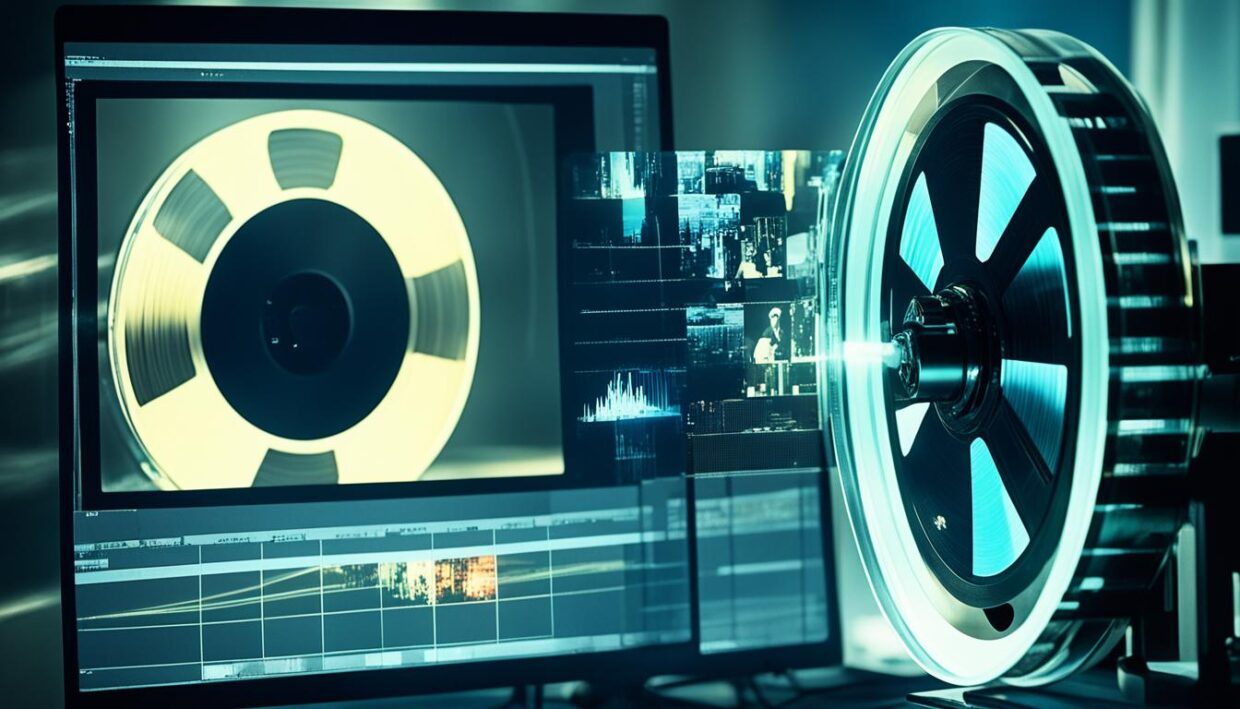
As the world continues to embrace the digital age, the role of technology in film preservation has become increasingly vital. By harnessing the power of digital tools and innovative restoration techniques, we can ensure that the cinematic treasures of the past continue to captivate and inspire audiences for generations to come.
Supporting Film Restoration Efforts
Film restoration is a crucial endeavor that preserves the rich heritage of cinema for future generations. However, these efforts often require significant resources and dedicated support. Fortunately, there are numerous ways for individuals to get involved and contribute to the preservation of classic movies.
Volunteer Opportunities
Many organizations dedicated to film restoration welcome volunteers to assist with various tasks, from digitizing and cataloging archival materials to hands-on restoration work. By volunteering, individuals can directly participate in the process of bringing cinematic gems back to life, ensuring their continued accessibility and appreciation.
Advocacy and Awareness
Raising awareness about the importance of film restoration can have a profound impact. Individuals can advocate for the cause by sharing information on social media, writing blogs, or engaging with local film communities. By educating others about the challenges and triumphs of restoring classic films, enthusiasts can inspire more people to get involved and support these efforts.
Financial Contributions
Financial support is crucial for sustaining film restoration projects. Individuals can explore opportunities to donate or contribute to organizations dedicated to preserving cinematic history. These donations can fund the acquisition of rare materials, the application of advanced restoration techniques, and the creation of accessible digital archives.
By engaging in these diverse ways, film enthusiasts can play a vital role in ensuring the survival and celebration of classic movies. Through volunteering, advocacy, and financial contributions, everyone can make a difference in safeguarding the legacy of cinema for future generations to discover and appreciate.

“The preservation of our cinematic heritage is not only a matter of cultural importance, but also a responsibility to future audiences who deserve to experience the magic of these timeless films.” – Martin Scorsese, renowned filmmaker and film preservation advocate.
Restoring Cultural Gems
Restoring classic films is not merely about reviving cinematic experiences; it is a profound endeavor to preserve cultural heritage and ensure that the rich tapestry of filmmaking history is passed down to future generations. These restored works serve as valuable windows into the past, fostering a deeper understanding and appreciation for the evolution of the art form.
Preserving Film History for Future Generations
The JBFC Restored & Rediscovered Film Preservation Festival is a prime example of the efforts to safeguard cinematic treasures. Scheduled from May 13-19, 2024, with additional screenings extended through May 20-23, the festival will celebrate the restoration of iconic titles such as Mahjong (1996), The Third Man, Peeping Tom, Hugo (2011), and the rare The Rare Blue Apes of Cannibal Isle (1974).
The festival’s diverse lineup showcases the collaborative work of experts, filmmakers, archivists, curators, and restorers. Partnerships with organizations like IndieCollect, Janus Films, Kino Lorber, Milestone Films, Rialto Pictures, The Film Foundation, and Vinegar Syndrome bring a wealth of expertise in film preservation to the event.
Restoration efforts highlighted during the festival include the restoration supervised by Ross Lipman from Corpus Fluxus for Household Saints (1993) by Lightbox Film Center at the University of the Arts (Philadelphia) in collaboration with Milestone Films. Funding for restorations like Bushman (1971) was provided by the Hobson/Lucas Family Foundation and additional support from Peter Conheim and Cinema Preservation Alliance.
The festival’s mission to restore cultural gems and preserve film history for future generations is a testament to the enduring significance of cinema as a medium that transcends time and connects us with our collective cultural heritage.

Behind the Scenes: A Composer’s Journey
In the captivating world of classic film restoration, the role of the film composer is often overlooked, yet their contributions are integral to reviving the cinematic treasures of the past. From the silent era’s live musical accompaniment to the contemporary era’s innovative soundscapes, the evolution of film scoring has been a dynamic and influential part of cinema’s rich history.
For seasoned film composers, the scoring process for restored classics involves a delicate balance of respecting the original cultural influences and collaborating closely with filmmakers to craft a musical narrative that breathes new life into the restored visuals. This symphony of creativity not only enhances the emotional impact of the film but also preserves the essence of the original work for future generations to discover and appreciate.
Take, for instance, the case of the first official commercial edition of the soundtrack for Robert Altman’s film Images, released by Quartet Records in 1972. The score, previously only available as a “composer’s promo” LP, now offers modern audiences a deeper understanding of how the music shaped the film’s haunting atmosphere and psychological themes.
Similarly, the expanded edition of the soundtrack for Steven Spielberg’s film Always, released by La-La Land Records in 1989, showcases the long-standing collaboration between composer John Williams and the acclaimed director. This 10th feature film collaboration between the two creatives is a testament to the power of their partnership in elevating the cinematic experience.
- Silent Era (1890s-1920s): Birth of cinema with live musicians accompanying silent films
- Birth of Film Scoring (1930s-1940s): Considered first instance of comprehensive film score with Max Steiner’s “King Kong” (1933)
- Technological Advancements (1950s-1960s): Introduction of magnetic tape and innovative recording techniques
- Electronic Experimentation (1970s-1980s): Shift towards electronic music with composers like Vangelis and Wendy Carlos
- Contemporary Era (1990s-Present): Evolution of film scoring with composers like Hans Zimmer, Thomas Newman, and Danny Elfman
Ultimately, the journey of a film composer is one of collaboration, creativity, and a deep understanding of the emotional and psychological impact of music on the cinematic experience. By delving into the behind-the-scenes process, we uncover the integral role these artists play in preserving the cultural gems of the past and shaping the future of film restoration.
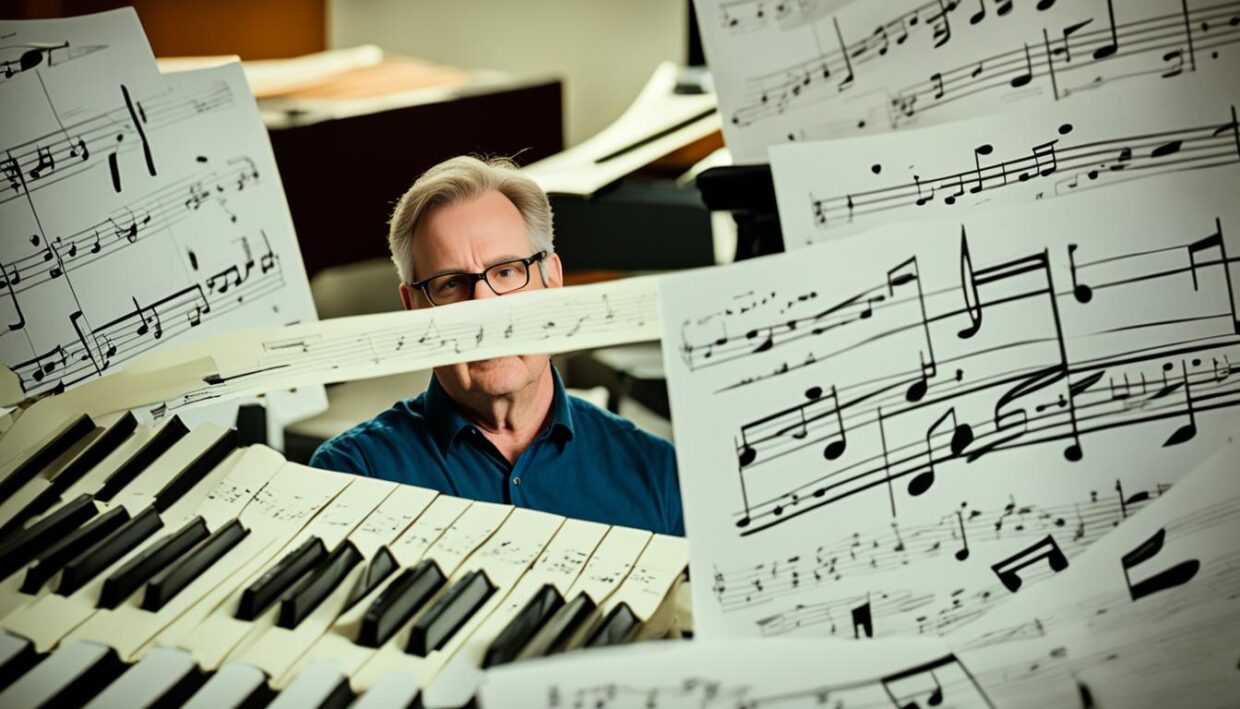
The Future of Film Preservation
As technology continues to evolve, the future of film preservation holds promising advancements in digital archiving, restoration techniques, and global accessibility. However, the success of these efforts relies on sustained community engagement, advocacy, and the dedication of passionate individuals committed to safeguarding the legacy of classic cinema.
One significant development is the increasing use of 70mm prints for restoration projects, providing an enhanced viewing experience for cinema enthusiasts. Film stock itself remains a stable medium, with the potential to last for hundreds of years when stored properly, making it a viable option for long-term preservation compared to digital formats like LTO tape with a shorter lifespan.
While the upfront cost of preserving films on film may be higher, the long-term cost-effectiveness of this approach outweighs the need for constant migration required in digital preservation. Nonetheless, independent filmmakers still face challenges with digital preservation, including the need for ongoing migration, multiple backups, and ensuring film availability on streaming platforms.
| Metric | Film Preservation | Digital Preservation |
|---|---|---|
| Longevity | Hundreds of years | 15-30 years |
| Upfront Cost | Higher | Lower |
| Long-term Cost | Lower | Higher |
| Authenticity | Maintains original aesthetic | Potential for deviation |
Despite the challenges, the demand for film exhibition in its original format remains strong, as evidenced by packed theaters showcasing 35mm presentations. This underscores the importance of preserving films on celluloid to maintain the authenticity and artistic vision of the filmmakers.
Ultimately, the future of film preservation relies on a multifaceted approach that leverages technological advancements, fosters community engagement, and ensures the continued dedication of individuals and institutions passionate about safeguarding the rich cinematic heritage for generations to come.
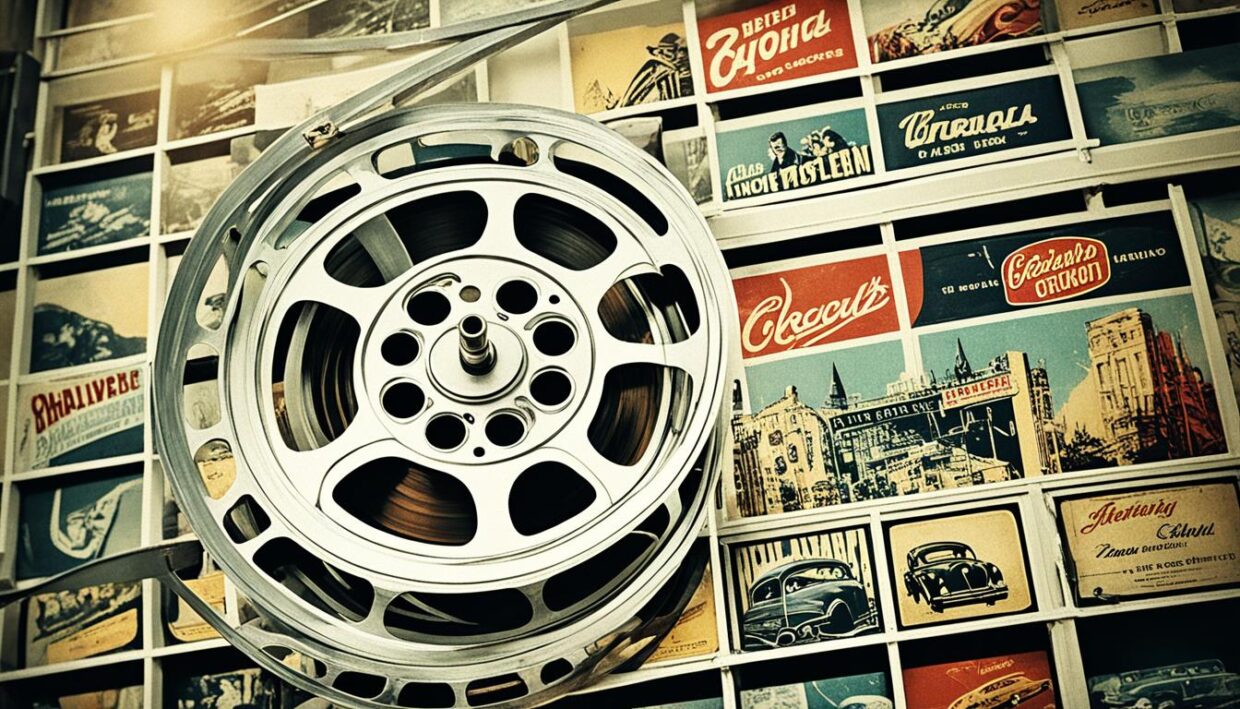
Conclusion
The restoration and revitalization of classic films is a crucial endeavor that preserves the rich history and cultural significance of cinema. By restoring these timeless stories and experiences, we can ensure that they continue to captivate and inspire audiences for generations to come, honoring the legacy of filmmaking and its enduring impact on our shared cultural heritage.
From the efforts of streaming platforms like Netflix, Warner Archive Collection, and Disney Signature Collection, to the meticulous curation of prestigious events like Cannes Classics, the dedication to preserving classic films has never been more evident. These initiatives not only safeguard cinematic gems but also foster a deeper appreciation for the art form, empowering film enthusiasts, scholars, and the general public to explore the depths of classic film restoration.
As technology continues to evolve, the tools and techniques used in the restoration process also advance, further enhancing the quality and accessibility of these restored classics. By embracing innovative technologies and collaborative efforts, the film industry can ensure that the cultural legacy of cinema remains vibrant, inspiring new generations to discover and cherish the enduring magic of classic films.














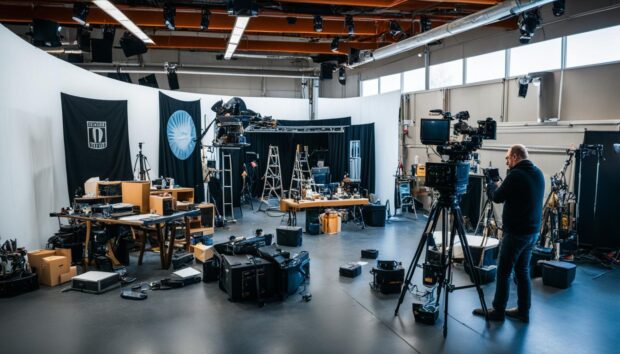
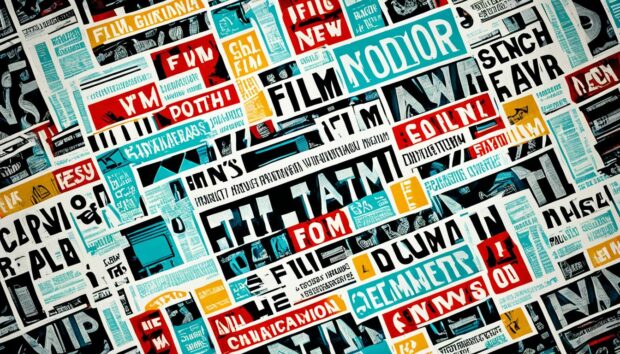





Be the first to leave a comment